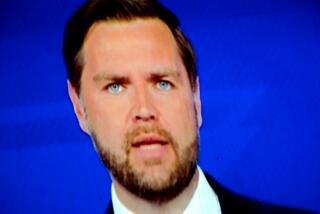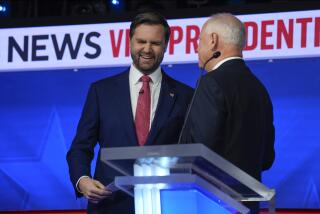Choosing Two for the Ticket
- Share via
WASHINGTON — Since World War II, half of our eight Presidents have come up from the vice presidency and two other vice presidents have won presidential nominations. Yet there is something quite cavalier about the way running mates are selected. The last time the public had a say was in 1956, when Adlai E. Stevenson allowed the Democratic delegates to decide the matter.
Accidental U.S. Presidents have ranged from monumental mediocrities like Millard Fillmore to Mount Rushmore types like Theodore Roosevelt. Only 15 years ago, nominees of both parties made critical mistakes picking running mates. George McGovern’s campaign self-destructed when the electorate learned that his first choice, Sen. Thomas F. Eagleton of Missouri, had undergone psychiatric treatment. Winner Richard M. Nixon was eventually no luckier; Spiro T. Agnew was forced to resign as vice president in 1973 after tax-evasion charges.
Originally, the office was awarded to the runner-up in the general election. And a look at history adds more weight to Supreme Court Justice Thurgood Marshall’s argument that the Founding Fathers were not necessarily the last word on good government.
In the 1800 election, Thomas Jefferson and Aaron Burr tied with 73 electoral votes each, and the race was decided in the House of Representatives where Alexander Hamilton swung the decision to Jefferson. The perilous nature of original intent was illuminated in 1804 when Vice President Burr killed Hamilton in a duel. Just before the killing, in a climate of rancor, the Constitution was amended to allow the presidential nominees to name their own running mates. Since then, nominees have normally exercised autocratic power and most often selected someone to woo a specific group. Geraldine A. Ferraro’s nomination, for instance, was a classic case of political symbolism to appeal to women voters.
The logical way to a running mate would be to choose the runner-up from the primaries, as Ronald Reagan did in 1980 and John F. Kennedy in 1960. The only other time this has happened, however, was in 1876, when Samuel J. Tilden was the Democratic candidate.
Instead, presidential nominees usually ignore their serious primary rivals, often at the expense of their own chances. A Jimmy Carter-Edward M. Kennedy slate in 1980 or a Gerald R. Ford-Ronald Reagan team in 1976 could conceivably have changed the outcomes. Yet personality conflicts precluded practicality. Now, it’s almost picking time for next year’s No. 2 nominees, sometimes called the sidecar candidates.
On the Republican side, we know at least who is not likely; George Bush can hardly relish the idea of being history’s first 12-year veep. Sen. Bob Dole of Kansas had an unpleasant experience running for second place in 1976; besides, he has a better job now as Senate minority leader. Howard H. Baker Jr., former Senate leader, now White House chief of staff, is overqualified. Two serious contenders could be retired Nevada Sen. Paul Laxalt, the President’s close friend, and New York Rep. Jack Kemp, the supply-siders’ ardent signal-caller. But Laxalt has been wounded by a long libel suit and Kemp has yet to inspire broad appeal.
The Democrats have an embarrassment of potential riches because all the presidential candidates seem quite suitable for second place. Any one of the so-called “Seven Dwarfs” might do.
But with a large field of presidential candidates and could-be candidates, what is beginning to worry Democrats most is a nightmare vision of a truly open convention, of no candidate coming to Atlanta with more than 35% of the delegate votes.
In that case, the power broker could be Jesse Jackson, who could take as much as 90% of the black vote in the Southern regional primaries next March. If Jackson’s secret ambition is to be the first black vice presidential nominee, the Democrats could again be in big trouble. Since the day Gary Hart dropped out, Jackson tides have menaced the party mainstream. For six weeks, Democrats walked on cats’ paws, until impetuous Sen. Joseph R. Biden Jr. (D-Del.) said what the cautious had been afraid to say: Jackson is unacceptable as a running mate. The problem is not that Jackson is black but that he is a radical of the left--as surely as George C. Wallace was a radical of the right in 1968 and similarly unacceptable.
The parallel goes further. Wallace was a spoiler; his American Independent Party took 13% of the vote and probably threw the race to Nixon. At the core of Jackson’s power in the party is the threat of his mounting an independent presidential candidacy after the convention.
In theory, the vice presidency is not so much an office that you run for as hope for. In practice, it’s an opportunity that you position yourself for. “I’m running for President, not vice president”; that’s what they all say.
Not since 1920 has America seen a race so up for grabs. That was the year Republicans took 10 ballots to settle on Warren G. Harding for President, while the Democrats exhausted 44 votes before nominating James M. Cox.
That was also the year the tickets were historically bottom-heavy. The most interesting match-up was between the two vice presidential candidates--Calvin Coolidge and Franklin D. Roosevelt.
More to Read
Get the L.A. Times Politics newsletter
Deeply reported insights into legislation, politics and policy from Sacramento, Washington and beyond. In your inbox twice per week.
You may occasionally receive promotional content from the Los Angeles Times.








